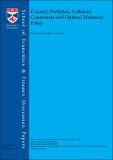Files in this item
Country Portfolios, collateral constraints and optimal monetary policy
Item metadata
| dc.contributor.author | Senay, Ozge | |
| dc.contributor.author | Sutherland, Alan James | |
| dc.date.accessioned | 2016-02-04T15:40:11Z | |
| dc.date.available | 2016-02-04T15:40:11Z | |
| dc.date.issued | 2016-01-29 | |
| dc.identifier | 240691200 | |
| dc.identifier | 468008f7-cf9b-4c6c-9d8a-5bb2fccb91b7 | |
| dc.identifier.citation | Senay , O & Sutherland , A J 2016 ' Country Portfolios, collateral constraints and optimal monetary policy ' School of Economics & Finance Discussion Paper , no. 1604 , University of St Andrews , St Andrews , pp. 1-32 . | en |
| dc.identifier.issn | 0962-4031 | |
| dc.identifier.other | ORCID: /0000-0002-0175-3886/work/60426732 | |
| dc.identifier.other | ORCID: /0000-0002-8310-968X/work/60426898 | |
| dc.identifier.uri | https://hdl.handle.net/10023/8131 | |
| dc.description | This research is supported by ESRC Award Number ES/I024174/1. | en |
| dc.description.abstract | Recent literature shows that, when international financial trade is absent, optimal policy deviates significantly from strict inflation targeting, but when there is trade in equities and bonds, optimal policy is close to strict inflation targeting. A separate line of literature shows that collateral constraints can imply that cross-border portfolio holdings act as a shock transmission mechanism which significantly undermines risk sharing. This raises an important question: does asset trade in the presence of collateral constraints imply a greater role for monetary policy as a risk sharing device? This paper finds that the combination of asset trade with collateral constraints does imply a potentially large welfare gain from optimal policy (relative to inflation targeting). However, the welfare gain of optimal policy is even larger when there is no international asset trade (but collateral constraints bind within each country). In other words, the risk sharing role of asset trade tends to reduce the welfare gains from policy optimisation even when collateral constraints act as a shock transmission mechanism. This is true even when there are large and persistent collateral constraint shocks. | |
| dc.format.extent | 32 | |
| dc.format.extent | 462822 | |
| dc.language.iso | eng | |
| dc.publisher | University of St Andrews | |
| dc.relation.ispartof | en | |
| dc.relation.ispartofseries | School of Economics & Finance Discussion Paper | en |
| dc.subject | Optimal monetary policy | en |
| dc.subject | Financial market structure | en |
| dc.subject | Country Portfolios | en |
| dc.subject | Collateral constraints | en |
| dc.subject | HB Economic Theory | en |
| dc.subject | BDC | en |
| dc.subject.lcc | HB | en |
| dc.title | Country Portfolios, collateral constraints and optimal monetary policy | en |
| dc.type | Working or discussion paper | en |
| dc.contributor.sponsor | Economic & Social Research Council | en |
| dc.contributor.institution | University of St Andrews. School of Economics and Finance | en |
| dc.identifier.url | https://ideas.repec.org/p/san/wpecon/1604.html | en |
| dc.identifier.grantnumber | RES-156-25-0027 | en |
This item appears in the following Collection(s)
Items in the St Andrews Research Repository are protected by copyright, with all rights reserved, unless otherwise indicated.

